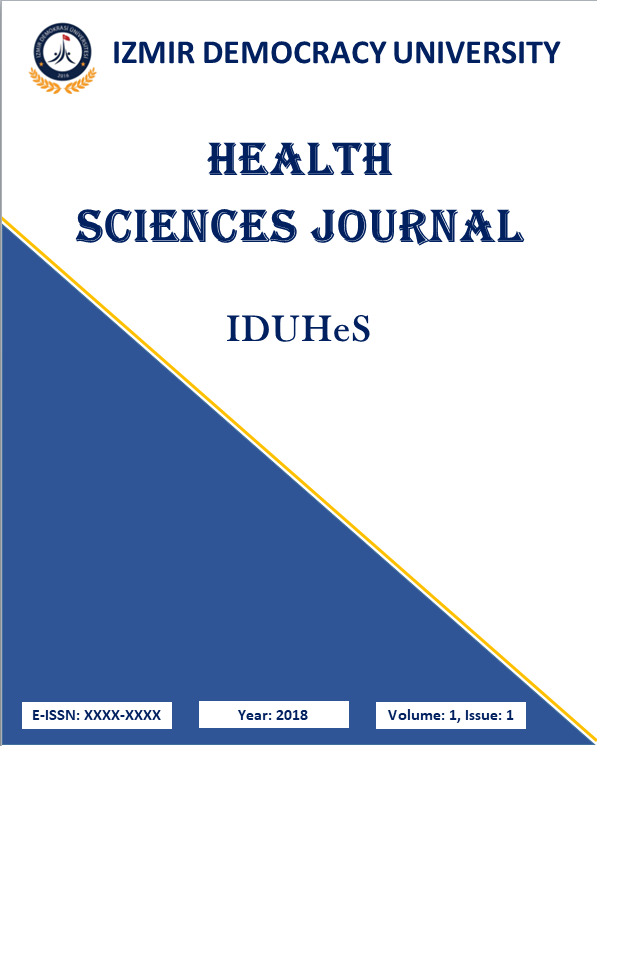NEKROTİZAN FASİİTLİ OLGULARDA TEK BAŞINA AMİLAZ DEĞERİ CİDDİYETİ BELİRLEMEDE LRINEC SKORLAMA SİSTEMİNE ÜSTÜN MÜDÜR?
Nekrotizan fasit günümüzde nadir görülen, cilt altı dokular ve fasya tabakasının nekrozu ile karakterize, hayatı ileri derecede tehdit eden birçeşit yumuşak doku enfeksiyonudur. Bu çalışma ile günümüzde nekrotizan fasiitli hastaların prognozunu belirlemede sıklıkla kullanılan birskorlama sistemi olan LRINEC (Laboratory Risk Indicator for NECrotizing fasciits) ile özellikle pankreatit hastalığı ile birlikte anılmaklaberaber; infantiller, gastroenterit, doku perforasyonu ve doku nekrozlarında değeri artan biyokimyasal belirteçlerden olan amilazın nekrotizanfasit olgularında prognoz değerlendirmede birbirlerine olan üstünlüklerini değerlendirmeyi amaçladık. Çalışmaya dahil olan hastaların 19’uerkek (%46.3), 22’si kadındı (%53.7). Çalışmamızda göze çarpan ve en sık etyolojik faktör olduğu düşünülen lezyon perianal abse idi. (n:12)Diğer etyolojik faktörler arasında; geçirilmiş operasyon, benzer bölgeye yapılmış çoklu enjeksiyon ve idiyopatik sebepler mevcuttu. Olgularaeşlik eden ek dahili problemlerden dikkati en çok diabetes mellitus çekmekteydi. (n:18) 7 hastada eşlik eden malignite durumu mevcuttu.(akciğer ca, mide ca, kolon ca, endometrium ca ve AML) Tüm olgulara tanı koyulmasını takiben cerrahi debridman işlemi uygulandı vekanamalı doku görülene dek işleme devam edildi. Çoğu hastada tekrarlayan debridmanlara gerek duyuldu. (n:32) Ortalama debridman sayısı 4.4idi. Bu çalışmayı düzenleme aşamasında dikkatimizi çeken ve çalışmayı yapmamıza sebep olan kan amilaz değerinin yatış sonrası ex olan 7hastanın 4 tanesinde referans değer olan 28-100 U/L’den yüksek olmasıydı. Ex olan bu hastanın ortalama LRINEC değerleri ise 4.2 idi (min:1,max:9). Sonuç olarak nekrotizan fasit tanısı alan hastalarda kan amilaz değerinin olağan referans değerleri üzerinde seyretmesi mevcuttakullanılan skorlama sistemi olan LRINEC’e yardımcı olabileceği ve hatta tek başına incelenmesinin hastalığın ciddiyetini belirlemede gözönünde tutulmasının klinisyenlere yardımcı olabileceği sonucunu düşünmekteyiz.Anahtar Kelimeler; Amilaz, Nekrotizan Fasit, Perianal Apse, Yumuşak DokuAbstractNecrotizing
Anahtar Kelimeler:
nekrotizan fasit, perianal apse, amilaz, yumuşak doku
IS THE AMYLASE VALUE ALONE IN PATIENTS WITH NECROTIZING FASCIITIS SUPERIOR TO THE LRINEC SCORING SYSTEM?
Necrotizing fasciate is a rare life-threatening soft tissue infection characterized by subcutaneous tissues and necrosis of the fascia layer. Withthis study, although it is mentioned with LRINEC (Laboratory Risk Indicator for NECrotizing fasciits), which is a frequently used scoringsystem to determine the prognosis of patients with necrotizing fasciitis, especially with pancreatitis disease; We aimed to evaluate thesuperiority of amylase, which is one of the biochemical markers that increase in infantile, gastroenteritis, tissue perforation and tissue necrosis,in necrotizing fasitis cases. Of the patients included in the study, 19 were male (46.3%) and 22 were female (53.7%). The most prominentetiological factor in our study was the lesion abscess perianal abscess. (n: 12) Among other etiological factors; There were previous operations,multiple injections to the region and idiopathic causes. Diabetes mellitus was most noticeable from the additional internal problemsaccompanying the cases. (n: 18) 7 patients had concomitant malignancy. (lung ca, stomach ca, colon ca, endometrium ca and AML) Followingthe diagnosis, surgical debridement was performed and the procedure was continued until bleeding tissue was seen. Repeated debridementswere needed in most patients. (n: 32) The average number of debridements was 4.4. The blood amylase value that caught our attention at thestage of organizing this study and caused us to perform the study was that it was higher than 28-100 U / L, which was the reference value in 4 of7 patients with ex-hospitalization. The average LRINEC values of this patient with Ex were 4.2. (min: 1, max: 9) As a result, we think that theblood amylase value above the usual reference values in patients diagnosed with necrotizing fasitis can help LRINEC, which is the currentlyused scoring system, and even examining it alone can help clinicians to consider the severity of the disease.
Keywords:
amylase, necrotizing fasciitis, perianal abscess, soft tissue,
___
- 1- Trent JT, Kirsner RS. Diagnosing necrotizing fasciitis. Adv Skin Wound Care 2002;15:135-8. 2- Ripley DL. Necrotizing fasciitis. Prim Care Update Ob Gyns 2001;7:142-7. 3- Carter PS, Banwell PE. Necrotising fasciitis: a new management algorithm based on clinical classification. Int Wound J 2004;1:189-98. 4- Wong CH, Khin LW, Heng KS, Tan KC, Low CO. The LRINEC (Laboratory Risk Indicator for Necrotizing Fasciitis) score: a tool for distinguishing necrotizing fasciitis from other soft tissue infections. Crit Care Med 2004;32:1535-41. 5- Boyer A, Vargas F, Coste F, Saubusse E, Castaing Y, Gbikpi-Benissan G, et al. Influence of surgical treatment timing on mortality from necrotizing soft tissue infections requiring intensive care management. Intensive Care Med 2009;35:847-53. 6- Ozgenel GY, Akin S, Kahveci R, Ozbek S, Ozcan M. Clinical evaluation and treatment results of 30 patients with necrotizing fasciitis. Ulus Travma Acil Cerrahi Derg 2004;10:110-4. 7- Canbaz H, Cağlikülekçi M, Altun U, Dirlik M, Türkmenoğlu O, Taşdelen B, et al. Fournier’s gangrene: analysis of risk factors affecting the prognosis and cost of therapy in 18 cases. Ulus Travma Acil Cerrahi Derg 2010;16:71-6. 8- Stevens DL, Bisno AL, Chambers HF, Everett ED, Dellinger P, Goldstein EJ, et al. Practice guidelines fort he diagnosis and management of skin and soft-tissue infections. Clin Infect Dis 2005;41:1373-406. 9- Tilkorn DJ, Citak M, Fehmer T, Ring A, Hauser J, Al Benna S, et al. Characteristics and differences in necrotizing fasciitis and gas forming myonecrosis: a series of 36 patients. Scand J Surg 2012;101:51-5. 10- Wong CH, Wang YS. The diagnosis of necrotizing fasciitis. Curr Opin Infect Dis 2005;18:101-6. 11- Turhan O, Buyuktuna SA, Inan D, Saba R, Yalçın AN. Clinical evaluation of forty-four patients with necrotizing fasciitis. Ulus Travma Acil Derg 2011;17:29-32. 12- Wang YS, Wong CH, Tay YK. Staging of necrotizing fasciitis based on the evolving cutaneous features. Int J Dermatol 2007;46:1036-41. 13- Wall DB, Klein SR, Black S, de Virgilio C. A simple model to help distinguish necrotizing fasciitis from nonnecrotizing soft tissue infection. J Am Coll Surg 2000;191:227-31. 14- Salt WB, Schenker S. Amylase-It’s clinical significance: a review of the literatüre. Medicine. 1976;55:269-89. 15- Sinha S, Khan H, Timms PM, Olagbaiye OA. Pancreatic-type hyperamylasemia and hyperlipasemia secondary to ruptured ovarian cyst: a case report abd review of the literatüre. J Emerg Med. 2010;38:463-6.
- Yayın Aralığı: Yılda 3 Sayı
- Başlangıç: 2018
- Yayıncı: İzmir Demokrasi Üniversitesi
